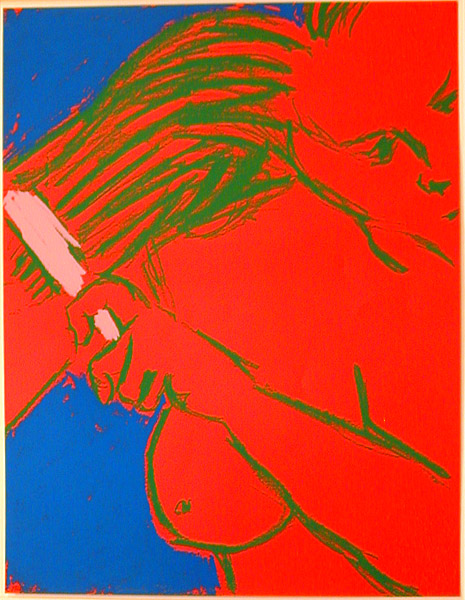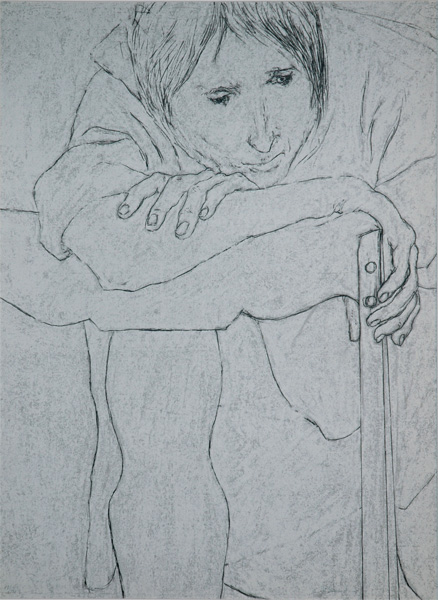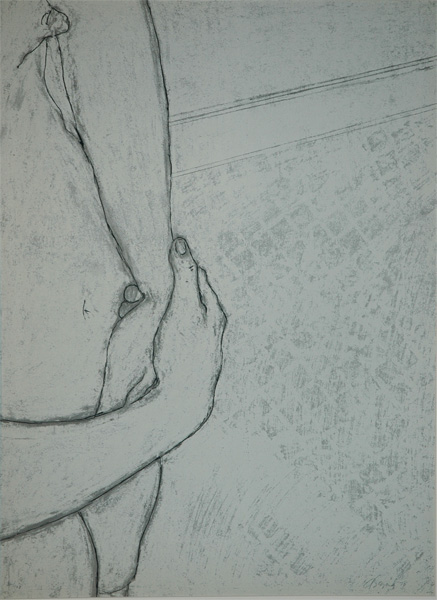|
For those who associate Segal's name solely with life-size white plaster figures, the diversity of Segal's art over the past forty years can come as a surprise. In addition to the striking sculptural environments that won him his reputation as an artist, Segal's early figure paintings, pastels from the 1960s, reliefs of the human figure, paraphrases of Cubist canvases and sculptures based on still-life paintings, extremely large portraits drawn during the 1990s and recent environments can be a revelation. Because of his interest in the everyday world, Segal was considered to be a founder of the POP Art movement in the early sixties, but his individual approach quickly distinguished him from the friends and colleagues with whom he exhibited. Far removed from the wit and sophisticated detachment of their art, the subject Segal deals with is the human condition, its solitude and fragility, which he expresses with a strongly felt sympathy.
George Segal was born in the Bronx on November 26, 1924. When he was fifteen, his family settled on a chicken farm in New Jersey. Segal helped his parents out on the farm while studying art, architecture and art education between 1941 and 1949 at Cooper Union, New York, Rutgers, Pratt Institute and New York University. After marrying in 1946, he temporarily put art aside and bought his own farm. In 1953, he met Allan Kaprow, renewed his contact with the art world and devoted himself to painting. In 1955, Segal began teaching art, and he continued to do so for a dozen years. His first solo show, which featured paintings, drawings and pastels, was held in 1956 at the Hansa Gallery, New York. Since then, not a year has gone by without a solo or group show, first in the United States, then in Europe.
In 1958, George Segal gladly hung up his pitchfork and converted his chicken coops into a series of studios. That same year, his farm served as the setting of the first "happening" organized by Allan Kaprow. The ensuing multimedia events likely influenced Segal, who, from this time on, began making life-size sculptures of people out of crude materials he was familiar with as a farmer: chicken wire, burlap and plaster. In 1961, using a new type of medical bandage designed to set fractures, Segal began casting his human figures directly from live models, capturing their essential traits, without worrying about details. Plastered white, frozen in stereotypical poses and installed in a realistic environment made even more real by the addition of ready-made props evoking the urban decor, Segal's figures, which convey his keen sense of observation, serve as symbols of a humanity that is dominated by social and material contingencies. His works, which juxtapose individuals and their surroundings, emanate an eerie feeling of alienation. In addition to representing the banality of modern life, Segal has created sculptural portraits, depictions of intimate activities like bathing and dressing, as well as overtly political subjects.
In 1963, during his first trip to Europe, he became friends with Giacometti, whom he met in Paris. The next year, the Moderna Museet, Stockholm, became the first museum to acquire one of his sculptures, Man on a Bicycle . In 1971, his works were exhibited in In 1971-72 he had a retrospective at Zurich, Munich, Cologne, Rotterdam, Paris, Leverkusen, and Tübingen.
Segal altered his technique in the mid-1970s. He began pouring plaster into his casts, using them as moulds to obtain more detailed figures, which he then usually painted a single bright hue. In 1976, he created his first bronze sculptures for public spaces. Two years later, his work was the subject of a major retrospective presented at the Walker Art Center, Minneapolis, at the San Francisco Museum of Modern Art and the Whitney Museum of American Art, New York. In 1982, an exhibition of his work was held at the Seibu Museum of Modern Art, Tokyo. In 1997 Marco Livingstone curated a major Segal retrospective at the Montreal Museum of Fine Art which then travelled to the Hirshhorn Museum and Sculpture Garden, Washington, DC, The Jewish Museum, New York, and the Miami Art Museum,. Segal's work is represented in leading American, European and Canadian museums. Segal was represented by the Sidney Janis Gallery in New York City, and had solo shows in 1965, 1967, 1969, 1970, 1971, 1973, 1974, 1986, 1988, 1989, 1992, and 1993; the Esperanza Gallery in Montreal presented solo shows in 1985 and 1987.
Selected Bibliography: Martin Freidman and Graham W.J. Beal, with commentaries by George Segal, George Segal: Sculptures (Minneapolis: Walker Art Center, 1978); Martin Friedman, Nobuyuki Hiromoto, Phyllis Tuchman, George Segal: Recent 15 Years (Tokyo: Galerie Tokoro and Sezon Museum of Art, 1996); Constance W. Glenn, George Segal: Pastels 1957-1965 (Long Beach: California State University, 1977); Paula Harper and Donald Kuspit, George Segal: Sculpture (Miami: University of Miami, Lowe Art Museum, 1983); Sam Hunter and Don Hawthorne, George Segal (NY: Rizzoli, 1984); Sam Hunter, George Segal (Barcelona, Poligrafa, 1989); Institute of Contemporary Art, George Segal: Environments (Philadelphia: Institute of Contemporary Art, 1976); Kunsthaus Zurich, George Segal (Zurich: Kunsthaus Zurich, 1971); Marco Livingstone, George Segal, A Retrospective: Sculptures, Paintings, Drawings (Montreal: The Montreal Museum of Fine Arts, 1997); Jan Van Der Marck, George Segal: Contemporary Artists Series 12 Human Situations (Chicago: Museum of Contemporary Art, 1968); Jan Van Der Marck, George Segal: Contemporary Artists Series (NY: Abrams, 1980); Jan van der Marck, The Sculpture of George Segal (NY: Abrams, 1975); Moderna Museet, Amerikansk POP-Konst: 106 former av korlek och fartvivlan. Jim Dine, Roy Lichtenstein, Claes Oldenburg, James Rosenquist, George Segal, Andy Warhol, Tom Wesslman (Stockholm: Moderna Museet, 1964); Marla Price, George Segal: Still Life and Related Works (Fort Worth: Fort Worth Modern Art Museum, 1990), reperes, cahiers d'art contemporain reperes No. 23: George Segal (Paris: Galerie Maeght Lelong, 1985); George Segal, George Segal (Paris: Galerie Ileana Sonnabend, 1963); George Segal, Painted Sculpture and Pastels (NY: Sidney Janis Gallery, 1989), George Segal, Sculpture for FDR Memorial Washington DC (NY: Sidney Janis Gallery, 1992); George Segal, Donald Judd, Allan Kaprow, et al, George Segal / cnacarchives 5 (Paris: CNAC, 1972); William C. Seitz, George Segal (London: Thames and Hudson, 1972); Sidney Janis Gallery, George Segal (NY: Sidney Janis Gallery, 1969); Phyllis Tuchman, George Segal NY: Abbeville Press, 1983).
|
|


